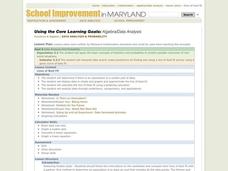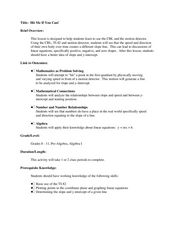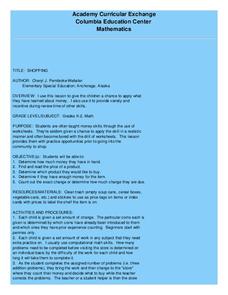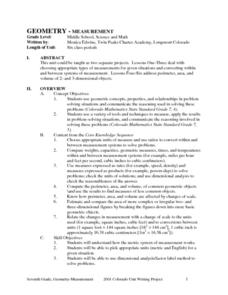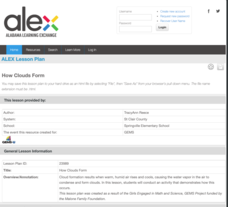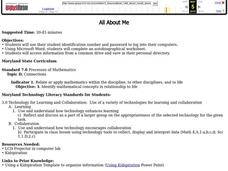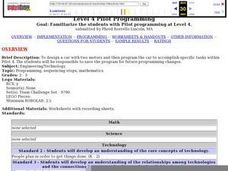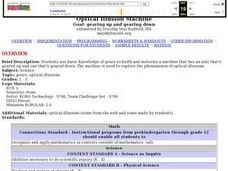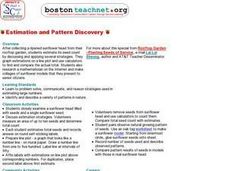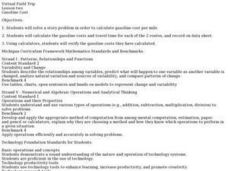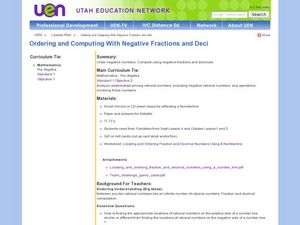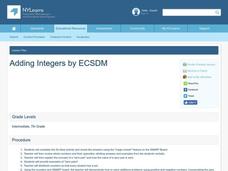Curated OER
Lines of Best Fit
Young scholars explore the concept of line of best fit. In this line of best fit lesson plan, students find lines of best fit in examples about riding your bike home from school and dentistry. Young scholars find two data points and find...
Curated OER
Similarity and Congruence
Students explore the concept of similarity and congruence. In this similarity and congruence lesson, students identify and verify whether or not two figures are similar, congruent, or neither. Students use postulates and theorems such as...
Curated OER
Are you in Golden Shape
Learners solve and verify the solution for unknown measures. In this geometry lesson, students identify the properties of circles. They use the arc, angle and segment relationship to find the missing measures.
Curated OER
Hit Me If You Can!
Students graph linear equations using slopes and intercepts. In this algebra lesson plan, students identify the slope as being positive,negative or undefined. They differentiate between different quadrants on a coordinate plane.
Curated OER
The Fat and the Lean
Students collect data on calorie intake. For this algebra lesson, students use the collection of data to make better eating decisions. They investigate the nutritional value in food using a graph and draw conclusion from their findings.
Curated OER
Risk Assessment and Geometry
Tenth graders study the concept of risk analysis as it relates to geometry. In this spatial relationship instructional activity, 10th graders are provided a set of coordinates to analyze a piece of land described. Students write a...
Curated OER
Shopping
Students determine how much money they have in hand, find and read the price of a product, determine which product to buy, determine if they have enough money, and count out exact change or determine how much change is due.
Curated OER
Geometry - Measurement
Students review the procedure for determining appropriate types of measurements for given situations and measurement conversions. They figure perimeter, area, and volume of 2 and 3 dimensional objects.
Alabama Learning Exchange
How Clouds Form
Young scholars analyze how clouds form. In this cloud formation lesson plan, students brainstorm types of clouds and what they think they're made of. Young scholars conduct an experiment to see how clouds form and discuss their...
Alabama Learning Exchange
Plants, Soil and Nutrients
Young scholars conduct an experiment. They review how to use the scientific method to conduct an experiment with white carnations and food coloring. They create a hypothesis and test it to better understand how plants get nutrients,...
Curated OER
Patterns
Students explore the concept of linear patterns by moving into different body poses. They also use MathKeys software to create linear patterns across a computer screen. In groups of three they take turns adding to the pattern.
Curated OER
Measuring Water Temperature
Students measure the temperature of three water sources. They collect data points every second for twenty five seconds for each sample using Lego Robolab temperature sensors, complete a worksheet, and analyze the data.
Curated OER
All About Me
Young scholars in a computer class use their student identification number and password to log into their computers. Using Microsoft Word, they complete an autobiographical worksheet/template and save the information on their own...
Curated OER
Diet: Cereal Grains and Nutrition
Students identify the nutritional value of various cereal grains. Without adding sugar, they cook with grains and compare the taste to cereal containing sugar. In addition, students complete worksheets about the different grains,...
Curated OER
Level 4 Pilot Programming
Students design a car with two motors and then program the car to accomplish specific tasks within Pilot 4. They work in teams in order to program their own car in order to accomplish specific tasks outlined by the teacher. They write...
Curated OER
Optical Illusion Machine
Students explore optical illusions. Using Legos, they construct and motorize a machine that has an axle that's geared up and geared down, complete a worksheet, and answer discussion questions.
Curated OER
Perimeter and Area of Similar Figures
Students explore the relationships between similar figures. In this relationships between similar figures lesson, students discuss relationships between perimeter, circumference, area, surface area, and volume of similar figures through...
Curated OER
Money
Second graders show combinations for $1.00. In this dollar combinations lesson, 2nd graders use nickels, dimes, and quarters to model and count combinations equaling $1.00.
Curated OER
Probability
Fourth graders predict future outcomes with an investigation of the mathematical principle of probability using spinners constructed by them. The spinner is a hands on application an they combine it with writing a ratio for the...
Curated OER
Estimation and Pattern Discovery
Students collect sunflower heads from their community garden. They estimate its seed count using different strategies. They graph their estimations on a graph and use calculators to find the actual total.
Curated OER
Virtual Field Trip/ Gasoline Cost
Students complete a word problem to determine the cost of gasoline per mile of their virtual field trip. They determine the travel time and gasoline costs for two routes and record the information on a data sheet. They check their work...
Curated OER
Fourths of Sets
Learners create a set of cards that represent factors of four and use these cards to play a game in which they practice separating numbers into fourths. They first practice separating numbers into fourths with a projected computer...
Curated OER
Ordering and Computing with Negative Fractions and Decimals
Seventh graders explore the concept of computing negative fractions and decimals. In this negative fractions and decimals lesson, 7th graders compare ordering positive fractions to ordering negative fractions. Students use mirrors to see...
Curated OER
Adding Integers
Pupils add integers using a number line. In this algebra lesson, students add one and two digit integers. They compare zero pairs and the addition of integers.
